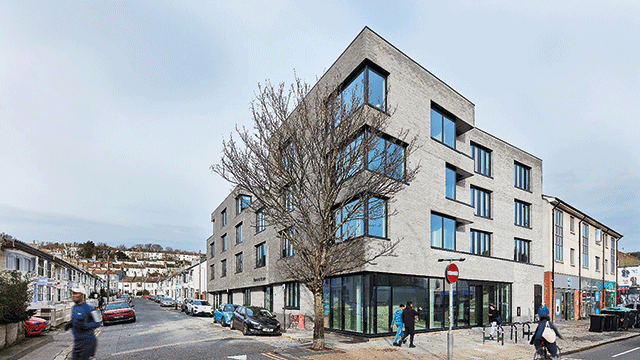Fresh air is good for you – obviously. Offered the choice, nobody opts for polluted office space. Ventilation is essential for healthy oxygen-breathing mammals. Agreed? Good, because it is at about this point that the debate over internal office air quality gets foggy.
Rates of ventilation, emerging and revised British Council of Offices standards, the level of exposure to volatile organic compounds such as formaldehyde and toluene, the quality of the evidence that cleaner air improves not just health but efficiency and productivity, and the eternal debate about sealed or openable windows – it’s an information smog.
The WELL Building certification is supposed to cut a path through the clouds of debate. Engineering business Cundall’s 15,400 sq ft London office at 1 Carter Lane, EC4, is the first in Europe to receive approval. During London’s high pollution days in January this year, Cundall compared the particulate concentration inside its office to the nearest monitoring stations in the City of London. It looked in detail at PM2.5, the smallest most invasive particulates, mostly from vehicles.
Real-world evidence
On 20 January, when outdoor levels were approaching WHO-recommended limits, Cundall’s filtered indoor air readings were well within the guidelines. For the rest of the period the most exciting daily event was a spike in VOCs around 10am as the sensor picked up the ethylene given off as nearby staff ate a banana.
Edwin Wealand, principal engineer at Cundall, says stopping polluted air getting inside is a challenge for older buildings. He explains: “There are solutions – you can, for instance, slightly over-pressurise the building with clean air, so up 10% or 20%, which means going to about 12 litres per person, per second. This then pushes the dirty air out of the cracks. But it is inefficient because it involved more cost heating or cooling more air. That’s how we do it in our Shanghai office.”
In leak-proof modern sealed office buildings, the problems are rather different. Sealed buildings can lead to a build-up of internal pollutants and carbon dioxide if ventilation is poor. “The difficulty is that unless you are monitoring closely, building managers won’t know there is a problem until people start reporting headaches,” Wealand warns.
Debate rages over whether windows should be openable or sealed (see box), and on appropriate ventilation levels. Lendlease likes to aim for ventilation 40% above the BCO recommendation of 10 litres per second, per person. The BCO is understood to be reviewing its ventilation standards.
Savills’ What Workers Want survey, carried out in conjunction with BCO, surveyed 1,132 office workers across the UK about what they want from their workplace. It showed that London office workers are unhappy with air quality in their workplace. Just 42% rated their satisfaction as high, compared with more than 60% in Cambridge and 57% in Manchester.
Savills’ data revealed that while air quality was important to office workers, it was not top of their list. Comfort, lighting and temperature were narrowly ahead. However, air quality is vastly more important to workers than many of the extras favoured by modern office occupiers – roughly twice as important as break-out areas, office plants, and fancy coloured walls and furniture.
But are significant gains in air quality only achieved at disproportionate cost? “I don’t think we have reached that point yet,” says Savills director Paul Davies. “That’s because systems are getting smarter. If you have good air monitoring – carbon dioxide, radon and other gas sensors – you can move air to the more densely occupied parts of the building, rather than just spreading your expensive fresh air evenly. That opens scope for efficiency because you can reduce plant size and cut costs.”
Airbrushing?
Behind the science lies another fresh-air dynamic: the danger of greenwash (or, in this case, airbrush).
For landlords and developers, being able to offer higher internal air quality is an important differentiator in the London office market. It is a low-cost product differentiation that has particular appeal for refurbishments.
Rebecca Pearce, head of sustainability at CBRE, strongly rejects the idea that internal air quality is being over-sold to help with product differentiation. Fresher air really does make a difference to occupiers, she says. Even so, she is aware of the airbrush risk.
“A developer does not want to be accused of wellness-washing their building. So things like internal air quality have to be done with integrity – and I believe developers have all the right motivations. But I totally get that it is a product differentiator, up to a point – and that is the point where good internal air quality becomes the norm. Attitudes will change in the same way they have for things like energy efficiency, and in a few years there won’t be a healthy-workspace premium, but an unhealthy workspace penalty.”
Chris Birch, director of sustainability at engineering consultancy Hilson Moran, says: “The costs are not massive compared to those of meeting the London carbon standard – you are looking at increasing build costs by a few per cent to meet the carbon targets, but only a fraction of a per cent for top internal air quality.
“Young people are very health-conscious, and internal air quality is definitely something that helps attract young people to your business – so employers are concerned. That makes it a differentiator for office space, because it enhances the chance of getting the best graduates.”
The fresh air debates have barely begun – whatever comes next, it is clear a wind of change is on the way.
Smoke and mirrors
Can cleaner fresh air make a significant difference to productivity? A frequently-quoted study from Harvard’s Centre for Health and the Global Environment seemed to suggest significant improvement in strategic thinking and crisis skills.
Others aren’t so sure. The study was based on just 24 people – and defining (let alone measuring) changes in “strategic thinking” has no agreed standard.
Specialists in environmental policy and scientific method say we should be cautious. Kristin Shrader-Frechette, a professor at the University of Notre Dame, told EG: “There is no sound scientific basis for relying on a sample of 24 people. The classic, statistically robust studies had 600,000-person sample sizes.”
The Harvard study – and its follow up Cog FX studies – are promoted on a site badged by United Technologies, which runs a multi-billion-dollar air cooling and treatment business. See http://naturalleader.com/thecogfxstudy .
Separate studies in 2003 linked improved air quality and ventilation with up to 11% gains in productivity – but not everyone is convinced it is that simple.
“Internal pollutants like solvents and volatile compounds dissipate over time, years sometimes. So judging the outcome is years away,” says Chris Birch, director of sustainability at engineering consultancy Hilson Moran. “But if you can change productivity by only a little, it has huge influence.”
James Pack, head of CoreNet Global UK’s sustainability community, says: “I am not sure there is a straight line from air quality to productivity because there are other issues, such as sleep.”
Pack says he treats research with caution but is encouraged that it shows the importance of better welfare. And that includes improved air quality.
Sealed or open?
Is it better to be able to open windows in and office or not?
Lendlease sustainability director Anita Mitchell says occupiers like a sealed building. “It’s important for us as a selling point,” she says. “We target 100% fresh air, with no circulation, and you do that by having a well-sealed building. There is a slight energy penalty compared to recycling, but the cost is small – single figures per cent.”
Lendlease likes to aim for ventilation 40% above the British Council for Offices recommendation.
James Pack, head of CoreNet Global UK’s sustainability community, isn’t so keen. “Problems with internal air quality are made far worse by the sealed box,” he says. Where noise issues are not also a problem – and in London they often are – an open window might be a solution in some circumstances.
David Thame











